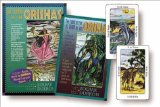
The Tarot of the Orishas: Complete Kit
, by Zolak
Llewellyn Worldwide, 1567188345, 77 cards and booklet, 2003
The use of the name “Tarot” is a deliberate misnomer. The cards which make up this deck correspond only loosely with those in a conventional Tarot deck. Unfortunately, there is no other word to describe the function of these cards. They are not “fortune-telling cards,” they are not a “game;” nor are they runes. They are comprised, like a “standard” Tarot deck of two separate components: There are 25 “primary cards” which approximate the Major Arcana and 52 “secondary cards,” divided into the four elements which approximate the Minor Arcana. There the similarities end.
The “Majors” are not numbered – to do so might invoke associations of “superiority/ inferiority” in the relationships of the ideas which they bring forth. Five of them have no correspondence to the “standard” Tarot, while two of the “standard” cards are not to be found (The Heirophant and Strength).
The “secondary” cards are numbered from 1 through 10 of each element, and also include an “Element card” in each suit – these “give our place within the elements, considering periods of time and its peculiarities and particulars;” a “Message of the Element card” which produce(s) a thought and a piece of advice intended for the consultant;” and, finally, an “Elemental card” which links them with “professions and personalities.”
Two copies of the instruction book are provided with the deck – one in English and one in Spanish. Since the Orishas are a concept drawn from Santeria (and most followers are Spanish-speaking) this is a decided advantage.
The images contained within this set are primitive. That is not to say that they are crude or unappealing, but they are more in the line of a Grant Wood rather than a Michelangelo. There is a sense of “real” versus “ideal.” The human images in this deck are not the idealized “David” style, but are much more representative of the carved African figures you occasionally find in resale shops – simple, basic, and easy to relate to.
I look forward to working with these cards for a long time, and, I expect that they, like the other decks I use, will continue to reveal more secrets the longer I use them. They will not replace a visit to a babalawo when needed, but they are certainly a system to provide guidance when needed.
There are layouts illustrated in the back of the booklet, including some of the “traditional” layouts used by most card readers. Each position is carefully explained for what it is, and how it relates to the other positions.
Some folks may have trouble relating to these cards, but if you give yourself the opportunity to work with them, I think you will find your time and effort well rewarded.








